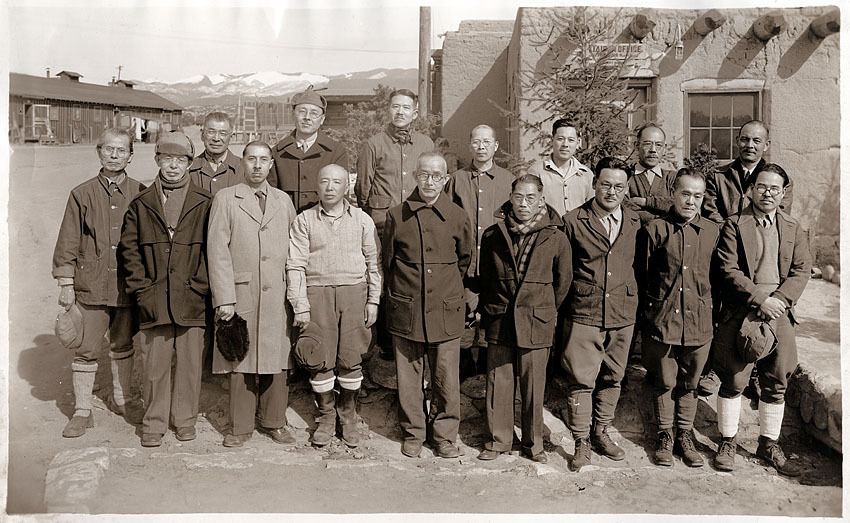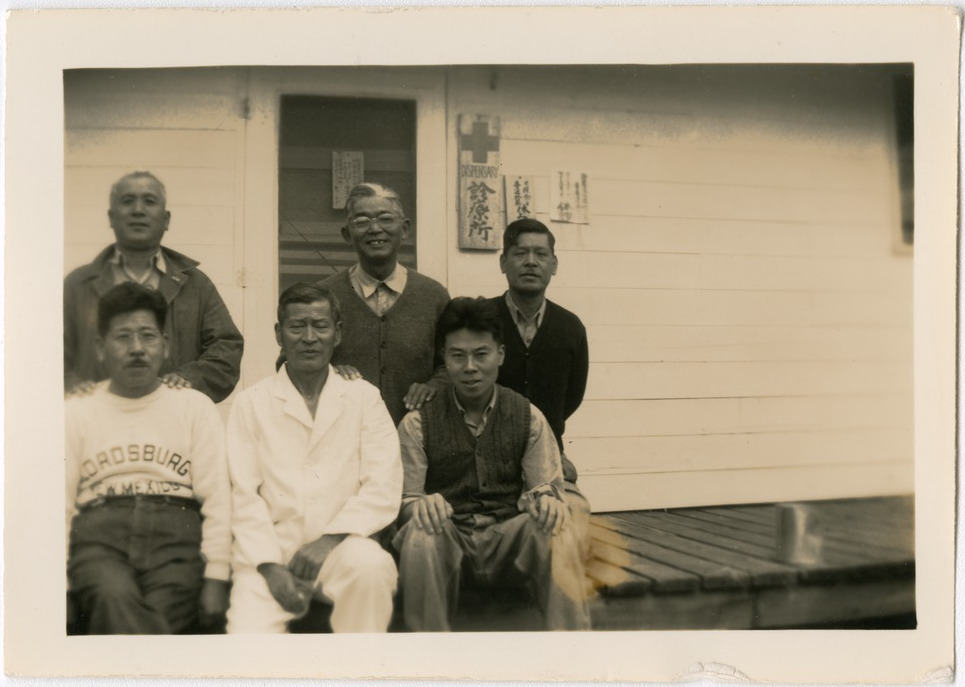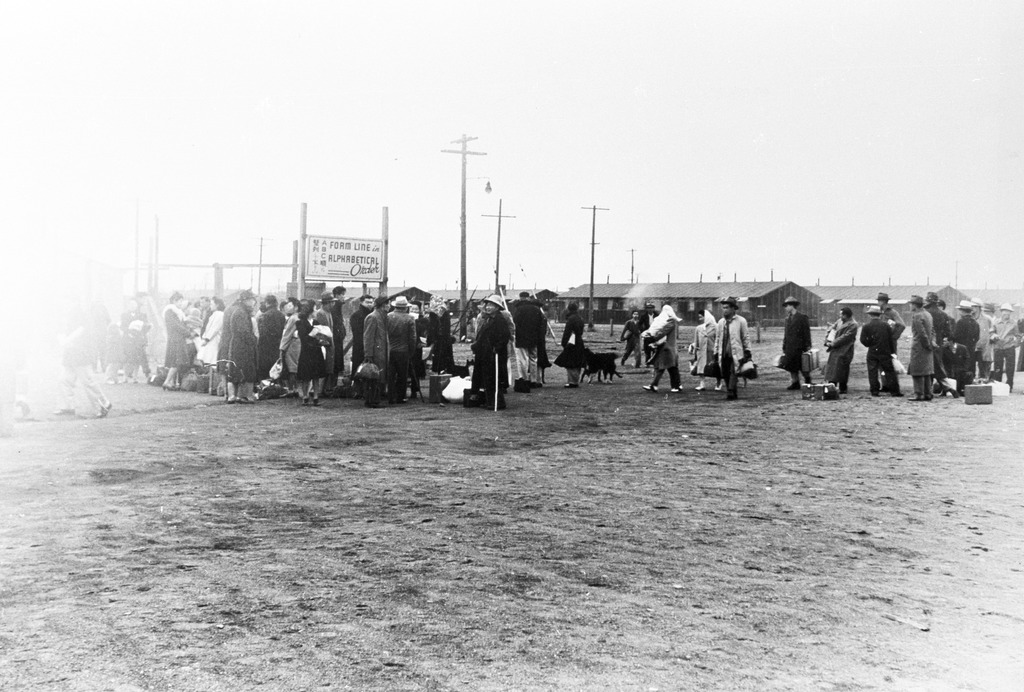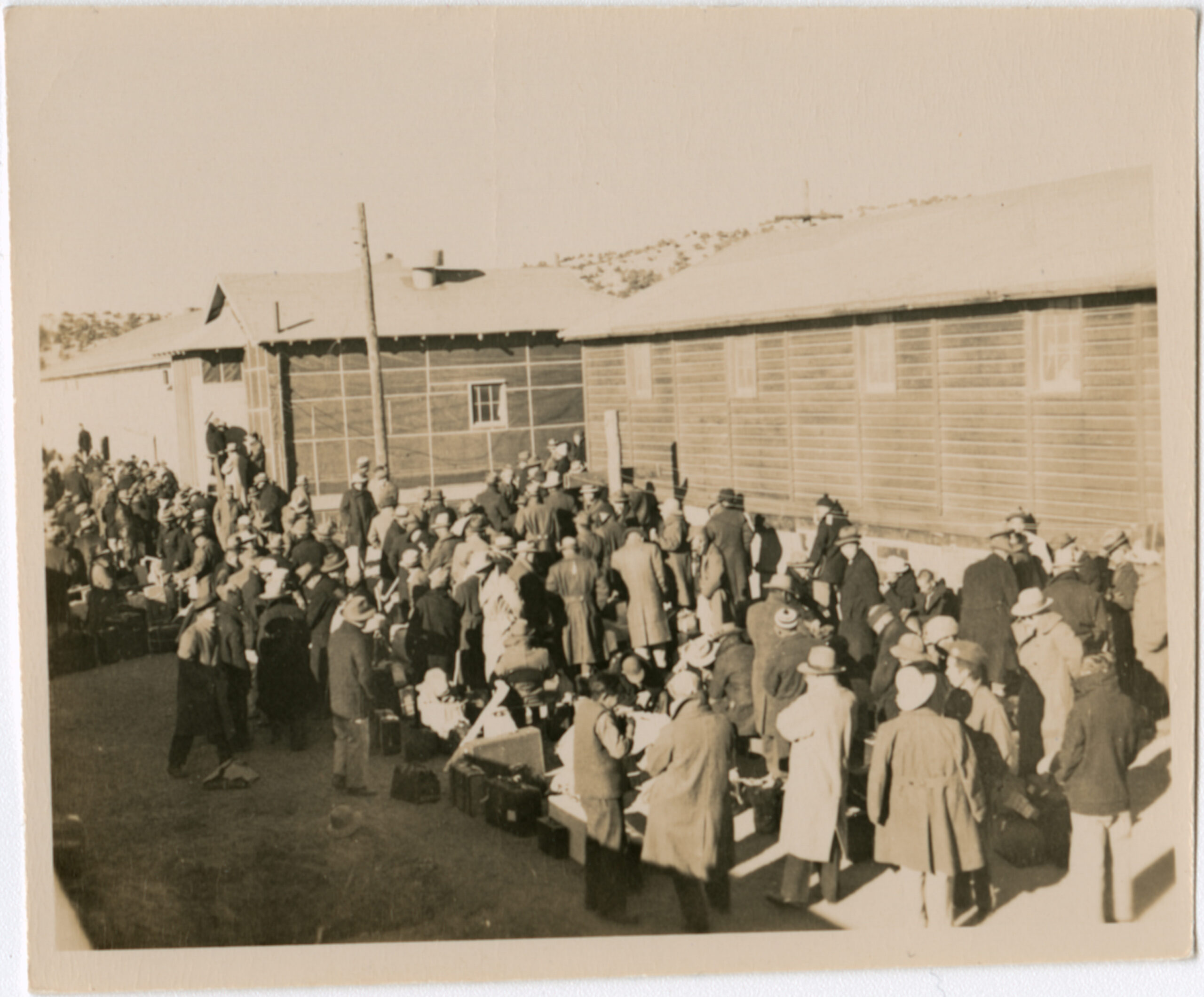April 3, 2025
Donald Trump’s recent attempt to invoke the Alien Enemies Act has sparked much interest in the roundup and internment of Issei during World War II, the most recent use of this little-known 1798 law. Often intermingled with the later mass removal of Japanese Americans from the West Coast under the authority of the infamous Executive Order 9066, this earlier action is not well understood even by those who know a fair amount about Japanese American history.
While there has been some recent scholarship on what took place in Hawai`i under martial law, there is relatively little on what took place on the continent. So here is a brief outline of what did take place and what our Issei leaders experienced the last time the Alien Enemies Act was invoked.
Various agencies had been investigating Japanese American communities for nearly a decade prior, leading to the creation of custodial detention lists of Issei—as well as immigrant Germans and Italians and other Europeans—to be picked up if and when war broke out. The Justice and War Departments came to an agreement on the detention of enemy aliens and prepared facilities for holding them. Thus prepared, President Franklin D. Roosevelt, under the auspices of the Alien Enemies Act of 1798, immediately issued a series of proclamations after the attack on Pearl Harbor, allowing for the apprehension of “alien enemies deemed dangerous to the public health or safety of the United States.”
The arrests began on December 7. Those arrested included both those we would consider today to be “Japanese American”—Issei community leaders such as Buddhist priests, Japanese language school personnel, members of Issei economic and cultural groups—as well as those we would deem “Japanese” such as Japanese consular officials and businessmen. In areas like the West Coast where there were substantial Japanese American communities, the former vastly outnumbered the latter; in areas where there were few Japanese Americans, the latter outnumbered the former.

The detention of these internees followed the basic pattern of the larger West Coast roundup that took place a few months later: initial detention in local facilities for a short period of time, followed by transfers to larger and more distant camps. In most locales, the internees went first to local prisons, jails, or immigration detention centers. Some of these short term sites on the West Coast included immigration station buildings in Seattle and San Francisco, and the Multnomah County Jail in Portland. Given the large Nikkei population in Southern California, there were multiple sites there, including the Los Angeles County Jail, the immigration station in San Pedro, and hastily assembled detention facilities in Tuna Canyon and Griffith Park. In other parts of the country, arrested Issei were typically held in local jails or prisons since there were relatively few of them, though in Chicago, at least, the INS imprisoned some Midwest Issei in a private home it had acquired, and in New York, Ellis Island was used to hold New York area internees.
A quick note on terminology before we dive in: while Densho and other Japanese American organizations have pushed to use “incarceration” instead of “internment” to refer to the mass roundup of West Coast Japanese Americans, the earlier roundup of Issei described here is properly called an “internment” and the prisoners themselves called “internees.”
Anywhere from days to weeks later, most West Coast Issei were transferred to one of three larger and more distant detention centers run by the INS: Fort Missoula, Montana; Fort Lincoln (Bismarck), North Dakota; and Santa Fe, New Mexico. Missoula was the first to hold Issei, with some locals being sent there right after the attack on Pearl Harbor. The first groups from the West Coast arrived on December 18. Issei from the West Coast began to arrive at Fort Lincoln in February and at Santa Fe in March. Each of the three camps ended up imprisoning about 1,000 Issei in this first phase.
In the meantime, the families of the interned men were often left in the dark for weeks as to the fate of their husbands and fathers. Since these men were often the sole breadwinners for their families, remaining family members—particularly younger families whose children were too young to work—were often plunged into financial crisis and were forced to navigate their later mass forced removal and incarceration on their own.
One of the most misunderstood aspect of the Issei roundup and internment was the fact that each received a hearing before an Alien Enemy Hearing Board, unlike Nikkei later rounded up under the auspices of Executive Order 9066 and apparently unlike those rounded up recently under the auspices of the Alien Enemies Act of 1798. The Justice Department’s Alien Enemy Control Unit established about 100 of these boards across the country. Each typically consisted of three civilians, one of whom had to be an attorney. The boards traveled to the main INS detention sites noted above, so most mainland Issei had their hearings in the spring and summer of 1942, after having been imprisoned for weeks or months.
The hearings were stacked against the internees, who were not allowed to have lawyers and not allowed to challenge the evidence against them, which was often of the hearsay variety. Sympathetic missionary Herbert Nicholson, who acted as a translator at some of the hearings, said of them that “the whole business was farce. Absolutely crazy!” I have read through some of the transcripts of these hearings, and they sometimes read as black comedy based on what we know today, given the absurdity of some of the charges and questioning.
The hearings were generally brief—typically under half-an-hour—with the board recommending either internment for the duration of the war on the one hand or release or parole on the other. But since they were still of Japanese descent, the latter group were released or paroled to communities that were either about to be forcibly removed to concentration camps or already had been. But at least these “lucky” Issei were able to rejoin their families if they had one. But some encountered difficulties back among other Japanese Americans, accused of being “inu” since they had been released while others remained interned separately. As far as I can tell, roughly half of the internees fell into each group, that is, about half were interned for the duration and half released or paroled.
Based on a prior agreement by the Justice and War Departments, the remaining Issei internees were moved from the INS camps to camps run by the army as their fates were decided. Thus, Missoula, Fort Lincoln, and Santa Fe were largely emptied of the interned Issei by the fall of 1942. But as we’ll see later, we haven’t heard the last of these camps. The main destinations for these men were Fort Sill, Oklahoma; Camp Livingston, Louisiana; and Lordsburg, New Mexico, with the last having the largest Issei population, peaking at 1,500 in November of 1942, some of whom came from Hawai`i or Alaska.

But by mid-1943, as the Army took in more POWs for detention in the army-run camps, space started to grow short, and internees were transferred back to Justice Department/INS camps. Most went to Santa Fe or Missoula, with the former getting the lion’s share; its internee population approached 1,900 by June 30, 1943. Both before and after the transfer to army camps, some of the internees were able to get clearance to transfer to WRA camps. Those with sons in the U.S. Army were given preference, and a few gained passage on the M.S. Gripsholm exchange ship, while others who had requested repatriation—or who had been fingered for deportation—were able to be reunited with families at the Crystal City INS camp.
But while the Issei internee population fell through 1944, a new group of prisoners arrived at Santa Fe and Ft. Lincoln in early/mid 1945: the “native born aliens” from Tule Lake—that is, nearly 2,000 Nisei who had renounced their citizenship. Unlike in the War Relocation Authority camps, there was no push to keep the internment camps open from inmates reluctant to leave the camps and face the hostility and housing shortages that awaited them on the outside. Most internees left by the end of 1945, whether to their prewar homes, to rejoin families in other places, or to Japan. But some remained interned into 1947.
In many cases, internees initially faced severe overcrowding, regimentation, and trigger-happy guards. Three of the seven incarcerated Japanese Americans who were shot to death by guards died in these camps, one at Fort Sill and two at Lordsburg. But as with the WRA system, conditions generally improved over time as war conditions improved and internees took more control of community life. Internees were also protected to some degree by the Geneva Convention and the general understanding that treatment of the internees would have some bearing on the treatment of Americans imprisoned by Japan. But with the exception of Crystal City—the one designated family camp—internees had to deal with the travails of an all male environment, separated from families. (For more on the conditions in these camps, see the encyclopedia articles on the various INS/army camps mentioned above.)

A quick word about a couple of other populations: German and other European immigrants were also selectively interned under the auspices of the Alien Enemy Act and went through a broadly similar experience as the Issei. Of course those who were released or paroled by hearing boards could return to their homes and families, unlike the Issei. Many were held at the same camps as the Issei, though in separate compounds. There was significant interaction between the two groups at some of the camps such as Fort Lincoln and Crystal City.
Internment of Hawai`i Nikkei followed a generally similar pattern, though with a few important differences. Because Hawai`i was immediately put under martial law after the attack on Pearl Harbor, local authorities were not limited to arresting just Issei, and a good number of Nisei community leaders—including two elected territorial legislators—were arrested and interned. (While some Nisei community leaders such as Mike Masaoka and Togo Tanaka were arrested on the continent, they were released in a matter of days.) Some of the Hawai`i Nisei were interned for the duration of the war, most ultimately at Honouliuli.
After being held in local facilities and at Sand Island, Hawai`i Issei internees were transferred to camps on the continent throughout 1942 and ended up in many of the same camps as their mainland counterparts. The Hawai`i internees also received similar hearings, though the rules were somewhat different under martial law. Most received their hearings in Honolulu (at the Immigration Station building), and they were, for instance, allowed to have lawyers; pioneering Nisei lawyer Masaji Marumoto represented many of them. But hearings were no more fair than the ones on the continent. And while some Hawai`i Issei reported being arrested by tall white men in suits as on the continent, some were arrested by apologetic Nisei policemen, a reflection of the very different demographics of the islands.
For whatever reason, there has been a lot more general scholarship on the Hawai`i Issei roundup and internment, and most of the recent translation of Issei internment memoirs have also come from Hawai`i. Works on the mainland internment camps tend to be quite specific, with none having the breadth of those on Hawai`i. The story of Issei internees from on the continent is a complicated, fascinating, and quite relevant one, so I hope someone writes the book on this someday. In the meantime, I have listed some additional resources below. See also the Densho Encyclopedia articles on the various internment camps.
—
By Brian Niiya, Densho Content Director
Further Reading
Ahn, Hyung-ju. “Koreans as Interpreters at Japanese Enemy Alien Detention Centers During World War II.” In Guilt By Association: Essays on Japanese Settlement, Internment, and Relocation in the Rocky Mountain West. Edited and contributions by Mike Mackey. Powell, Wyoming: Western History Publications, 2001. 101–16.
———. Between Two Adversaries: Korean Interpreters at Japanese Alien Enemy Detention Centers during World War II. Fullerton: Oral History Program, California State University, Fullerton, 2002.
Carroll, Kara, and Andrew B. Russell. “The Santa Fe Detention and Internment Camp.” Edited by Gail Okawa. In Confinement in the Land of Enchantment. Ed. Sarah R. Payne. Fort Collins, Colo.: Colorado State University, Public Lands History Center, [2017].
Christgau, John. “Enemies”: World War II Alien Internment. Ames: Iowa State University Press, 1985. [A history of the Fort Lincoln internment camp.]
Culley, John J. “The Santa Fe Internment Camp and the Justice Department Program for Enemy Aliens.” In Japanese Americans: From Relocation to Redress. Ed. by Roger Daniels, Sandra C. Taylor, and Harry H. L. Kitano. Salt Lake City: University of Utah Press, 1986. Revised edition. Seattle: University of Washington Press, 1991. 57-71.
———. “Trouble at the Lordsburg Internment Camp.” New Mexico Historical Review 60.3 (July 1985): 225-48.
Fiset, Louis. Imprisoned Apart: The World War II Correspondence of an Issei Couple. Foreword by Roger Daniels. Seattle: University of Washington Press, 1997.
Johnson, Hayley, and Sarah Simms. Beneath Heavy Pines in World War II Louisiana: The Japanese American Internment Experience in Camp Livingston. Lanham, Md.: Lexington Books, 2023.
Kanzaki, Stanley N. The Issei Prisoners of the San Pedro Internment Center. New York: Vantage Press, 2008. [A novel set in a fictionalized Lordsburg camp.]
Melzer, Richard. “Casualties of Caution and Fear: Life in Santa Fe’s Japanese Internment Camp, 1942–46.” In Essays in Twentieth-Century New Mexico History. Ed. Judith Boyce DeMark. Albuquerque: University of New Mexico Press, 1994. 213–40.
Matsumoto, Toru, and Marion Olive Lerrigo. A Brother Is a Stranger. New York: John Day Co., 1946.
Rogers, Everett M., and Nancy R. Bartlit. Silent Voices of World War II: When Sons of the Land of Enchantment Met Sons of the Land of the Rising Sun. Santa Fe: Sunstone Press, 2005.
Van Valkenburg, Carol Bulger. An Alien Place: The Fort Missoula, Montana, Detention Camp 1941-1944. Missoula, Mont.: Pictorial Histories Publishing Company, Inc., 1995, 2009.
Wegars, Priscilla. Imprisoned in Paradise: Japanese Internee Road Workers at the World War II Kooskia Internment Camp. Moscow, Idaho: Asian American Comparative Collection, 2010.———. As Rugged as the Terrain: CCC ‘Boys,’ Federal Convicts, and World War II Alien Internees Wrestle with a Mountain Wilderness. Foreword by Dick Henricks. Caldwell, Idaho: Caxton Press, 2013.
Overview Works that Include the Roundup and Detention of Enemy Aliens
Kashima, Tetsuden. Judgment Without Trial: Japanese American Imprisonment during World War II. Seattle: University of Washington Press, 2002.
Robinson, Greg. A Tragedy of Democracy: Japanese Confinement in North America. New York: Columbia University Press, 2009.
Hawai`i Internment
Furuya, Suikei. An Internment Odyssey: Haisho Tenten. Translated by Tatsumi Hayashi. Foreword by Gary Y. Okihiro. Introduction by Brian Niiya and Sheila Chun. Honolulu: Japanese Cultural Center of Hawai’i, 2017.
Hoshida, George and Tamae. Taken from the Paradise Isle: The Hoshida Family Story. Ed. Heidi Kim. Foreword by Franklin Odo. Boulder: University of Colorado Press, 2015.
Okawa, Gail. Remembering Our Grandfathers’ Exile: US Imprisonment of Hawaii’s Japanese in World War II. Honolulu: University of Hawai’i Press, 2020.
Okihiro, Gary Y. Cane Fires: The Anti-Japanese Movement in Hawaii, 1865-1945. Philadelphia: Temple University Press, 1991.
Scheiber, Harry N., and Jane L. Scheiber. Bayonets in Paradise: Martial Law in Hawai’i during World War II. Honolulu: University of Hawai’i Press, 2016
Soga, Yasutaro [Keiho]. Life behind Barbed Wire: The World War II Internment Memoirs of a Hawai’i Issei. Translated by Kihei Hirai. Honolulu: University of Hawai’i Press, 2008.
[Header: A large crowd of internees wait with their luggage in front of barracks at the Santa Fe internment camp. Courtesy of David Rogers.]
